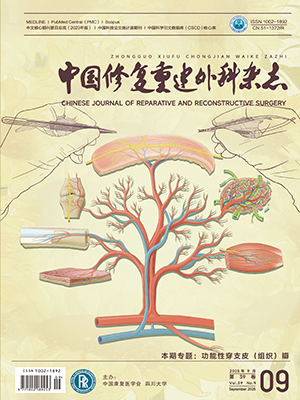| 1. |
Wang X, Hu W, Cao Y, et al. Dog sciatic nerve regeneration across a 30-mm defect bridged by a chitosan/PGA artificial nerve graft. Brain, 2005, 128(Pt 8): 1897-1910.
|
| 2. |
Wang Y, Zhao Y, Sun C, et al. Chitosan degradation products promote nerve regeneration by dtimulating Schwann cell proliferation via miR-27a/FOXO1 axis. Mol Neurobiol, 2016, 53(1): 28-39.
|
| 3. |
Peng Y, Li KY, Chen YF, et al. Beagle sciatic nerve regeneration across a 30 mm defect bridged by chitosan/PGA artificial nerve grafts. Injury, 2018, 49(8): 1477-1484.
|
| 4. |
Jiao H, Yao J, Yang Y, et al. Chitosan/polyglycolic acid nerve grafts for axon regeneration from prolonged axotomized neurons to chronically denervated segments. Biomaterials, 2009, 30(28): 5004-5018.
|
| 5. |
焦海山, 姚健, 任艳玲, 等. 甲壳素神经导管修复大鼠坐骨神经10 mm缺损的实验研究. 中国生物医学工程学报, 2008, 27(4): 597-602, 620.
|
| 6. |
Zhao Y, Liang Y, Ding S, et al. Application of conductive PPy/SF composite scaffold and electrical stimulation for neural tissue engineering. Biomaterials, 2020, 255: 120164. doi: 10.1016/j.biomaterials.2020.120164.
|
| 7. |
Huang J, Lu L, Zhang J, et al. Electrical stimulation to conductive scaffold promotes axonal regeneration and remyelination in a rat model of large nerve defect. PLoS One, 2012, 7(6): e39526. doi: 10.1371/journal.pone.0039526.
|
| 8. |
Baniasadi H, Ramazani SAA, Mashayekhan S. Fabrication and characterization of conductive chitosan/gelatin-based scaffolds for nerve tissue engineering. Int J Biol Macromol, 2015, 74: 360-366.
|
| 9. |
Wang Y, Zhang Y, Zhang Z, et al. An injectable high-conductive bimaterial scaffold for neural stimulation. Colloids Surf B Biointerfaces, 2020, 195: 111210. doi: 10.1016/j.colsurfb.2020.111210.
|
| 10. |
焦海山, 曹萍, 陈颖, 等. 纳米聚吡咯/甲壳素复合膜的制备及其生物相容性观察. 中国修复重建外科杂志, 2018, 32(8): 1081-1087.
|
| 11. |
Wan Y, Wu H, Wen D. Porous-conductive chitosan scaffolds for tissue engineering, 1. Preparation and characterization. Macromol Biosci, 2004, 4(9): 882-890.
|
| 12. |
Yang YM, Hu W, Wang XD, et al. The controlling biodegradation of chitosan fibers by N-acetylation in vitro and in vivo. J Mater Sci Mater Med, 2007, 18(11): 2117-2121.
|
| 13. |
董炎明, 许聪义, 汪剑炜, 等. 红外光谱法测定N-酰化壳聚糖的取代度. 中国科学 (B 辑), 2001, 31(2): 153-160.
|
| 14. |
Zhang PX, Han N, Kou YH, et al. Tissue engineering for the repair of peripheral nerve injury. Neural Regen Res, 2019, 14(1): 51-58.
|
| 15. |
Park S, Liu CY, Ward PJ, et al. Effects of repeated 20-Hz electrical stimulation on functional recovery following peripheral nerve injury. Neurorehabil Neural Repair, 2019, 33(9): 775-784.
|
| 16. |
Zuo KJ, Gordon T, Chan KM, et al. Electrical stimulation to enhance peripheral nerve regeneration: Update in molecular investigations and clinical translation. Exp Neurol, 2020, 332: 113397.
|
| 17. |
王爱勤. 甲壳素化学. 北京: 科学出版社, 2008: 226-227.
|
| 18. |
Shi G, Rouabhia M, Wang Z, et al. A novel electrically conductive and biodegradable composite made of polypyrrole nanoparticles and polylactide. Biomaterials, 2004, 25(13): 2477- 2488.
|
| 19. |
Neisi Z, Ansari-Asl Z, Jafarinejad-Farsangi S, et al. Synthesis, characterization and biocompatibility of polypyrrole/Cu (Ⅱ) metal-organic framework nanocomposites. Colloids Surf B Biointerfaces, 2019, 178: 365-376.
|
| 20. |
Freier T, Koh HS, Kazazian K, et al. Controlling cell adhesion and degradation of chitosan films by N-acetylation. Biomaterials, 2005, 26(29): 5872-5878.
|
| 21. |
Younes I, Rinaudo M. Chitin and chitosan preparation from marine sources. Structure, properties and applications. Mar Drugs, 2015, 13(3): 1133-1174.
|




